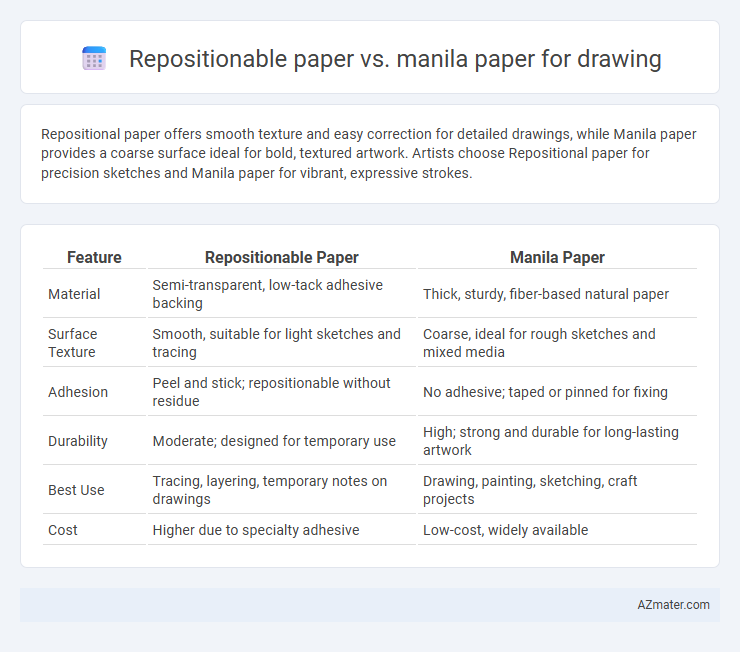Repositional paper offers smooth texture and easy correction for detailed drawings, while Manila paper provides a coarse surface ideal for bold, textured artwork. Artists choose Repositional paper for precision sketches and Manila paper for vibrant, expressive strokes.
Table of Comparison
| Feature | Repositionable Paper | Manila Paper |
|---|---|---|
| Material | Semi-transparent, low-tack adhesive backing | Thick, sturdy, fiber-based natural paper |
| Surface Texture | Smooth, suitable for light sketches and tracing | Coarse, ideal for rough sketches and mixed media |
| Adhesion | Peel and stick; repositionable without residue | No adhesive; taped or pinned for fixing |
| Durability | Moderate; designed for temporary use | High; strong and durable for long-lasting artwork |
| Best Use | Tracing, layering, temporary notes on drawings | Drawing, painting, sketching, craft projects |
| Cost | Higher due to specialty adhesive | Low-cost, widely available |
Introduction: Understanding Drawing Paper Options
Repositional paper offers a lightweight, translucent surface ideal for sketching and tracing, allowing artists to refine designs with ease and transfer without damage. Manila paper provides a sturdier, textured surface suitable for various dry media, favored for its affordability and durability in practice sketches and student work. Understanding these distinct characteristics helps artists select the optimal paper type to enhance their drawing techniques and achieve desired effects.
What is Repositional Paper?
Repositional paper is a specialized art paper designed with a low-tack adhesive backing, allowing it to be temporarily attached and repositioned on surfaces without leaving residue or damaging the artwork. It is ideal for artists who require flexibility in layout adjustments, stenciling, or tracing multiple layers during the drawing process. Compared to Manila paper, which is thicker and more absorbent, repositional paper offers smooth texture and easy removal, making it excellent for precision work and iterative drafts.
What is Manila Paper?
Manila paper is a sturdy, beige-colored sheet made from wood pulp commonly used for drawing and craft projects due to its durability and affordability. It features a slightly rough texture that holds various mediums such as pencil, charcoal, and pastel effectively, making it suitable for sketching and practice work. Compared to repositionable paper, manila paper does not have adhesive properties and is primarily valued for its resilience and ease of handling in art applications.
Surface Texture: Smoothness and Tooth
Repositional paper offers a smoother surface texture with minimal tooth, making it ideal for precise pencil shading and detailed line work, while Manila paper features a rougher texture with more pronounced tooth that grips charcoal and pastel better, enhancing textured and expressive strokes. The smoothness of repositional paper allows for easy blending and erasing, whereas the coarse texture of Manila paper provides increased friction, which holds pigment particles firmly. Artists select repositional paper for fine, controlled drawings and Manila paper for bold, textured artwork requiring medium adherence.
Durability and Strength Comparison
Repositional paper offers moderate durability with a smooth surface ideal for temporary sketches and layering in drawing projects, but it tends to lose adhesive quality over time. Manila paper boasts greater strength and resilience, making it suitable for heavy-duty use, repeated erasing, and mixed media applications without tearing easily. The fiber composition of Manila paper gives it superior tensile strength compared to the thinner, less durable repositional paper sheets.
Erasability and Reusability
Repositional paper offers excellent erasability due to its special adhesive backing, allowing drawings to be lifted and repositioned without damaging the surface. Manila paper, while more durable and suitable for long-lasting artwork, lacks effective erasability and is prone to smudging or tearing when erased repeatedly. For reusable drawing purposes, repositional paper provides superior flexibility and ease of corrections compared to the traditional manila paper.
Compatibility with Drawing Mediums
Repositional paper offers versatile compatibility with various drawing mediums such as graphite, charcoal, pastels, and ink, making it ideal for artists who frequently adjust their work. Its smooth surface allows for easy layering and blending without smudging, which is beneficial for detailed sketches and mixed media. Manila paper, being more textured and porous, excels with dry mediums like pencil and charcoal but may absorb ink or wet mediums unevenly, limiting its use for fine ink work or wet blending techniques.
Cost and Availability
Repositional paper offers a cost-effective option for artists needing temporary sketches, as it is generally more affordable than Manila paper, especially in bulk. Manila paper is widely available in most art supply stores and supermarkets, making it accessible for many users, though its price can vary depending on thickness and brand. Repositional paper's availability may be more limited, often found through specialized art suppliers or online retailers, affecting convenience for some buyers.
Environmental Considerations
Manila paper, made from natural fibers, is biodegradable and recyclable, aligning with eco-friendly art practices, whereas repositionable paper often contains synthetic adhesives or coatings that may hinder recyclability. Choosing Manila paper reduces environmental impact due to its compostable nature and lower chemical processing during production. Artists committed to sustainability should prefer Manila paper to minimize waste and promote environmentally responsible drawing materials.
Which Paper is Best for Drawing?
Manila paper features a coarse texture and sturdy surface ideal for rough sketches and mixed media, making it versatile for quick studies and lightweight drawing projects. Repositional paper, characterized by its smooth finish and adhesive backing, allows artists to reposition their work without damage, benefiting layered compositions or tracing techniques. For precision and detailed artwork, repositional paper is best, while manila paper suits broader, more experimental drawing styles.

Infographic: Repositional paper vs Manila paper for Drawing
 azmater.com
azmater.com